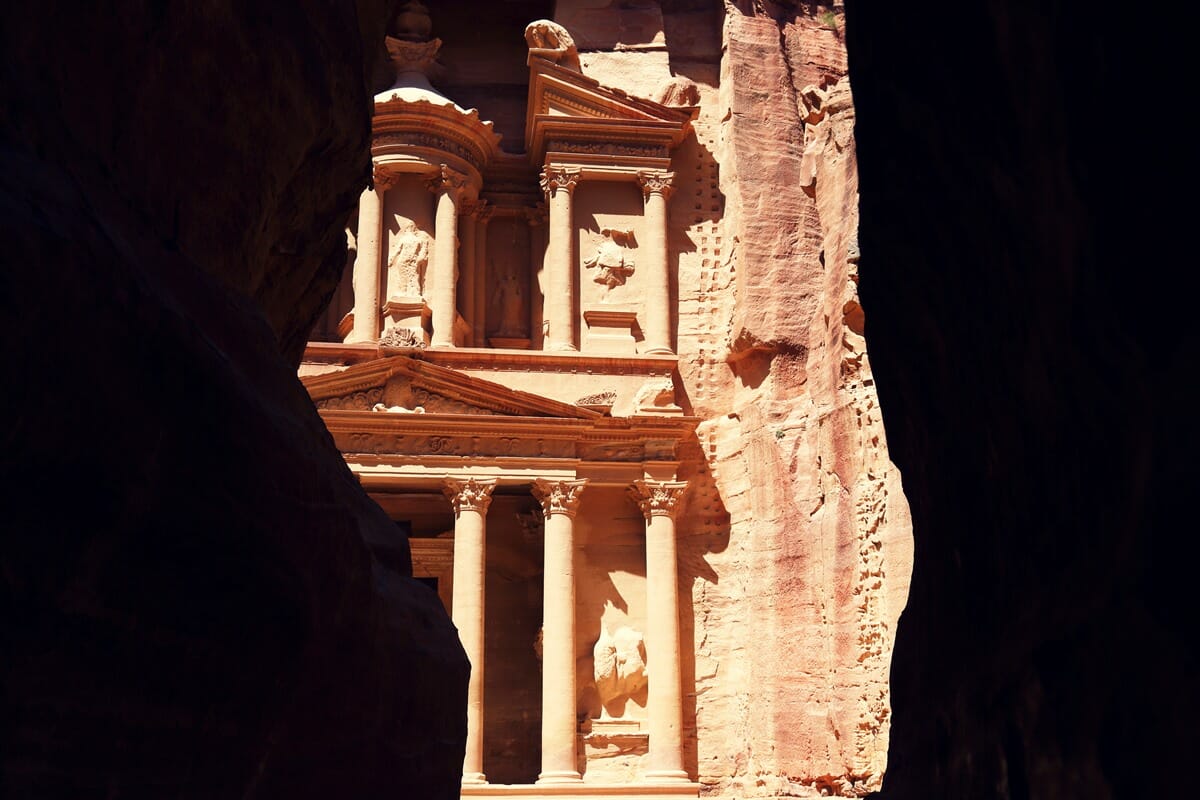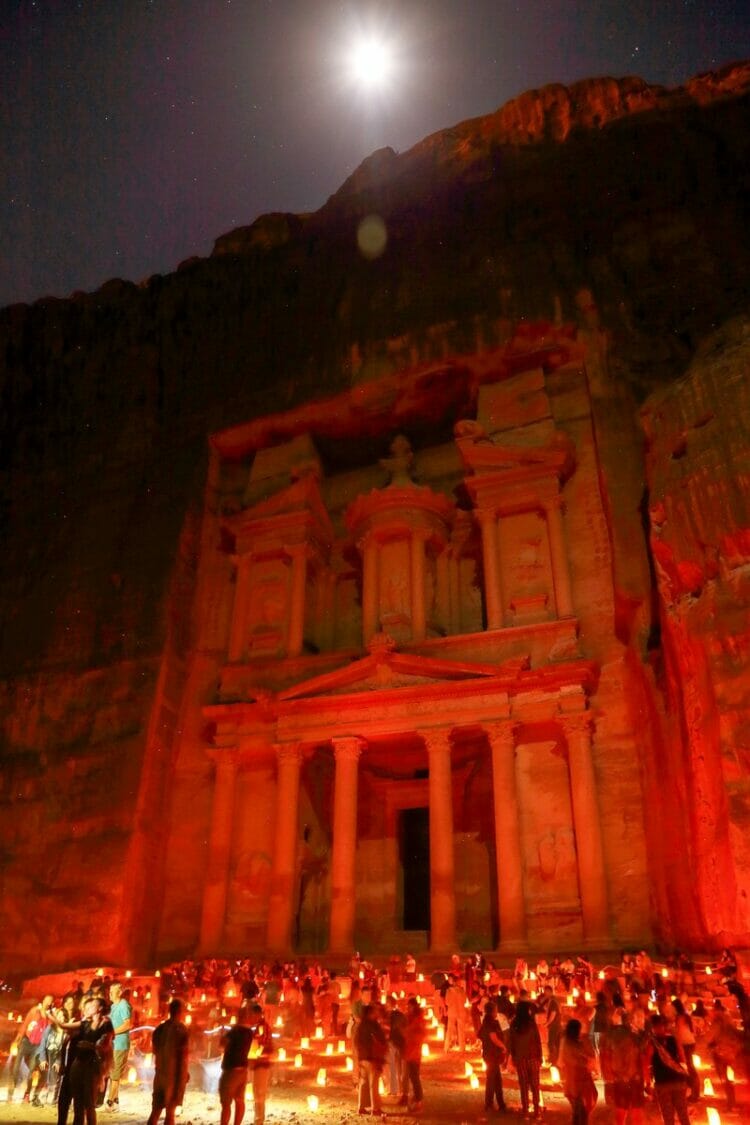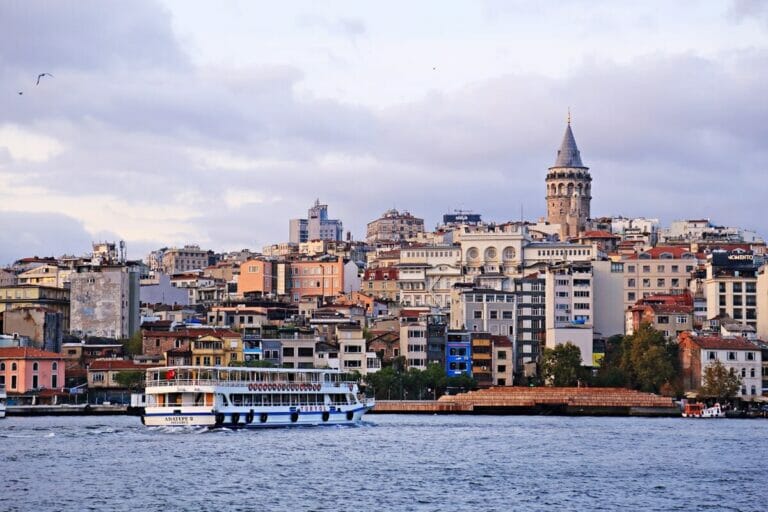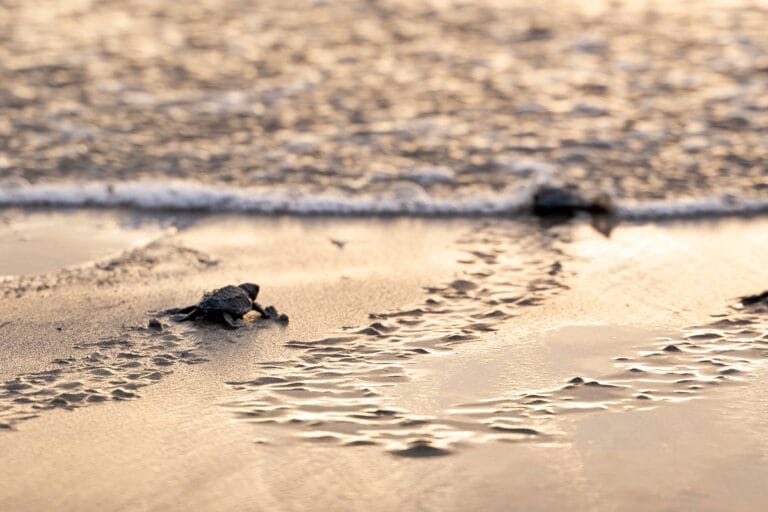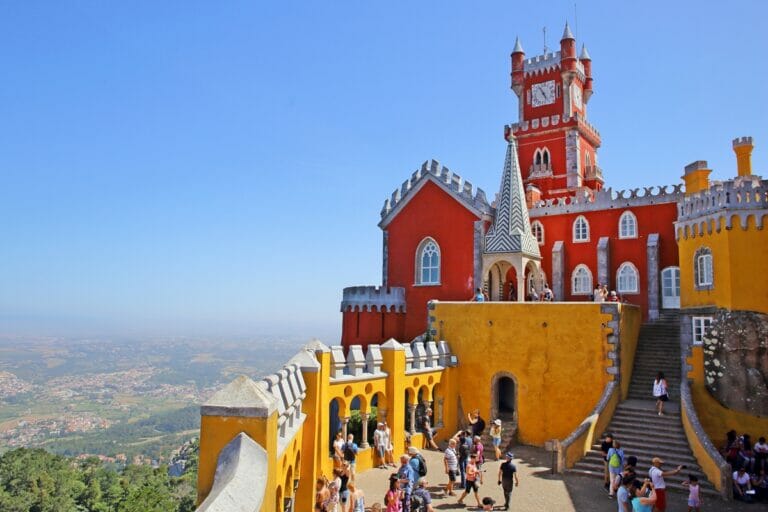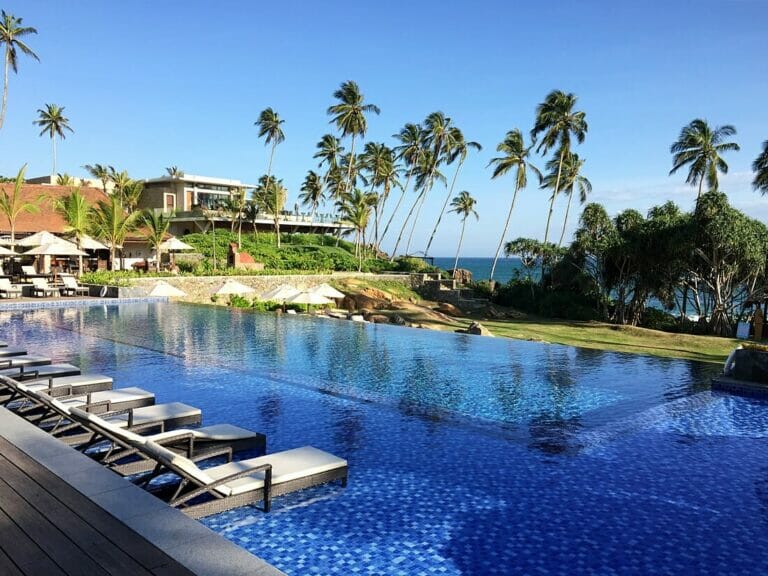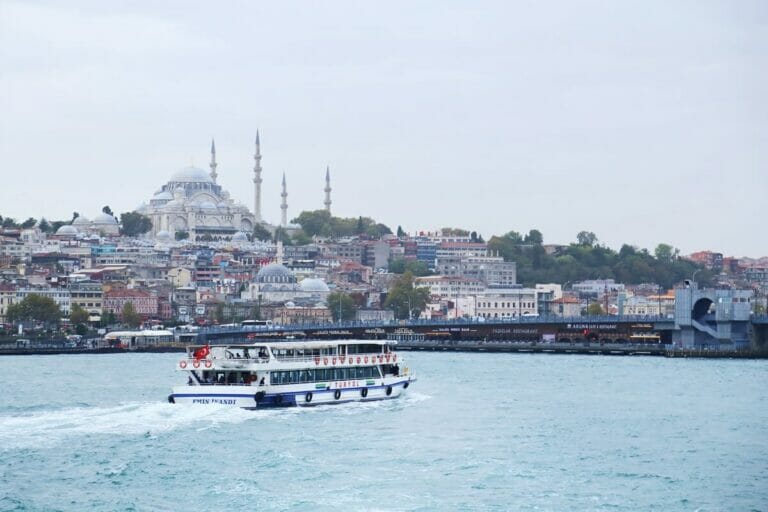A Practical Guide to Visiting Petra in Jordan (And What to See Beyond the Treasury)
The ancient site of Petra is one of the 7 New Wonders of the World – read on for everything you need to know to plan a perfect visit to Petra!
The ruins of Petra is Jordan’s most-visited tourist attraction and also one of the best preserved archaeological sites in the world. Though it’s not known precisely when the city was built, it’s thought to have prospered around the 1st century B.C. when Petra was known to the Nabataeans as “Raqmu”.
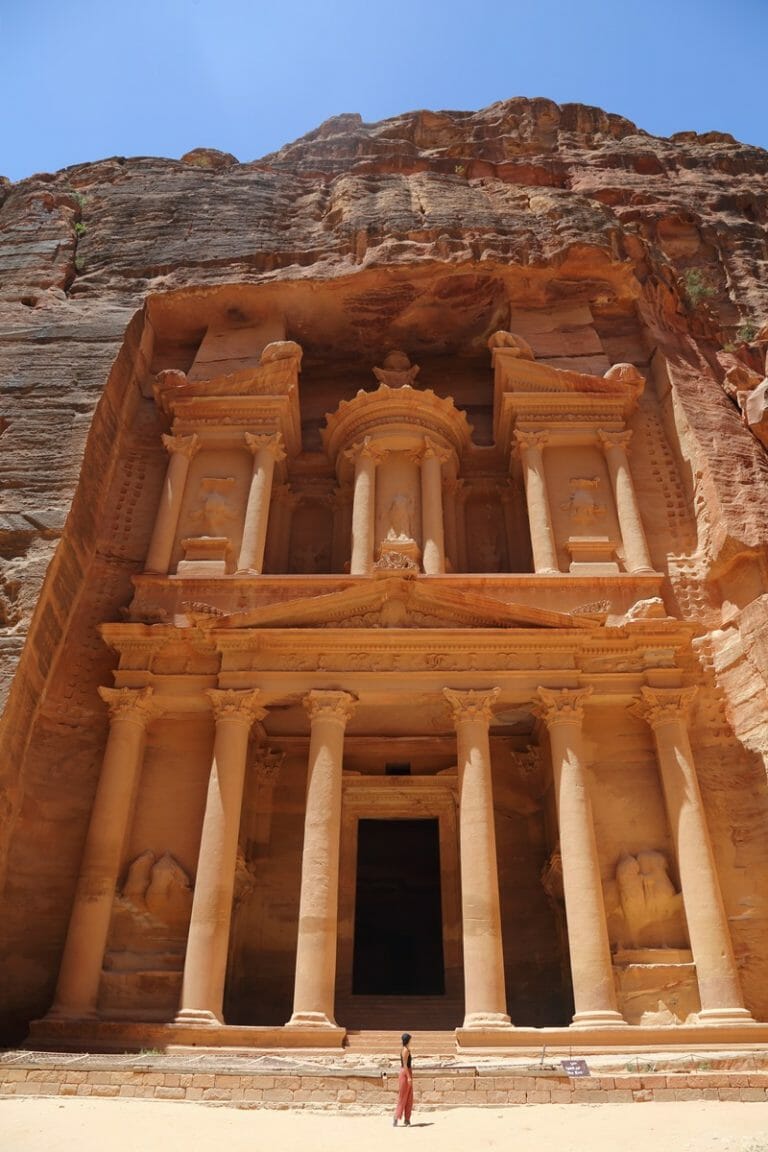
The city was a major trading hub for frankincense, myrrh and spices in the region, and was later annexed to the Roman Empire and continued to thrive until a large earthquake destroyed much of the city in the 4th century A.D.
It was largely deserted by the middle of the 7th century until in 1812, when a Swiss explorer set out to “rediscover” the lost city of Petra by convincing his Bedouin guide to take him there.
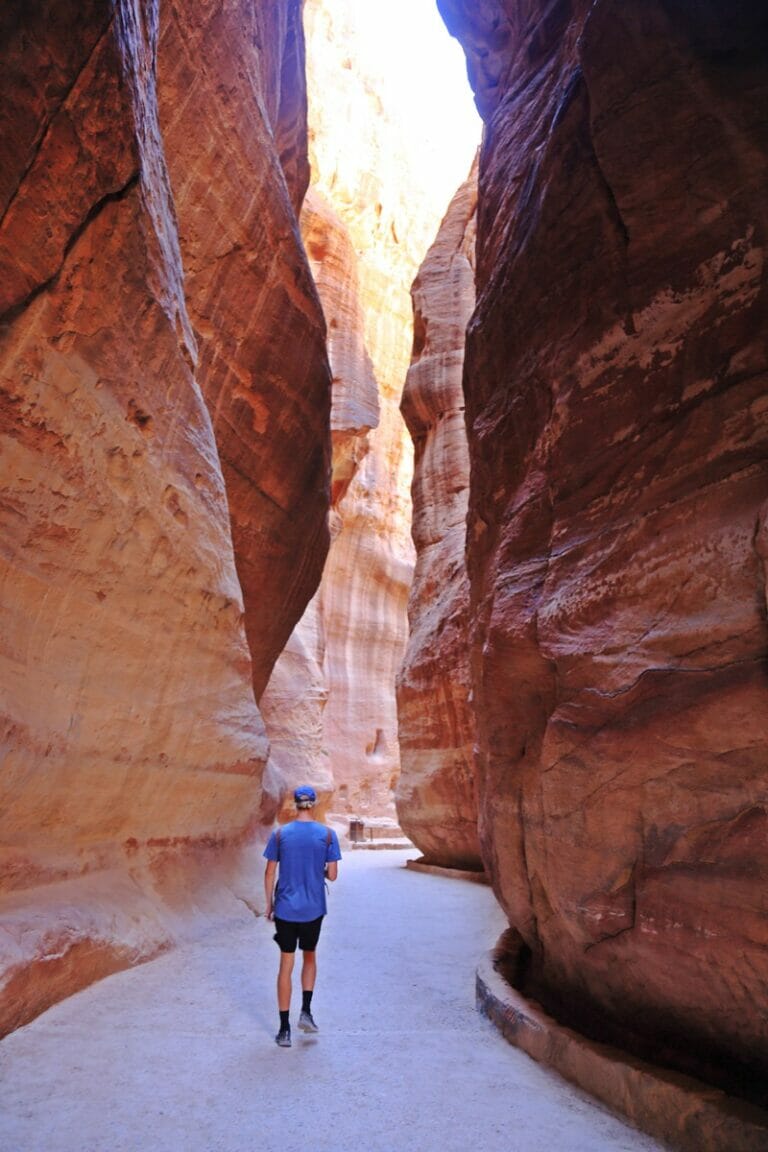
The Petra Archaeological Park in Jordan features spectacular rock-cut architecture set in a vibrant red sandstone landscape as well as towering mountains lined with deep passages and gorges.
The Nabataeans buried their dead in intricate tombs that were cut out of mountain sides, and the city was home to temples, a rock theatre, colonnaded street and churches.
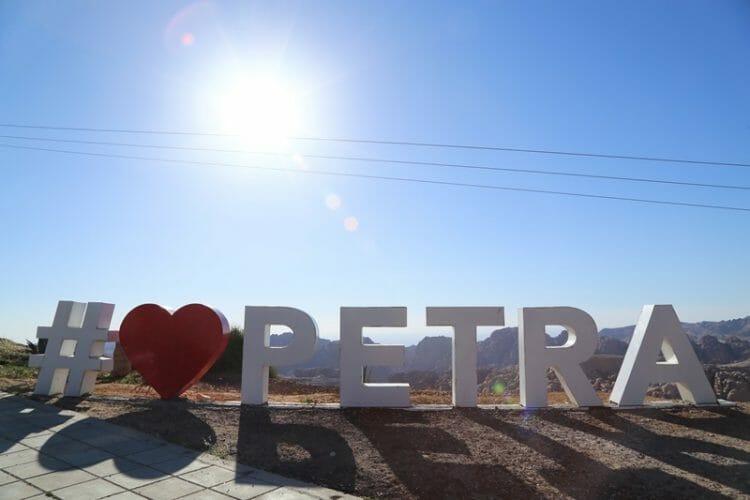
Petra is not only one of the “New Wonders of the World” but also a UNESCO World Heritage Site. The ruins of Petra was inscribed as a World Heritage Site for the “unique artistic achievement and an outstanding architectural ensemble of the first centuries BC to AD. The varied archaeological remains and architectural monuments from prehistoric times to the medieval periods bear exceptional testimony to the now lost civilisations which succeeded each other at the site” and “the vast extent of elaborate tomb and temple architecture; religious high places; the remnant channels, tunnels and diversion dams that combined with a vast network of cisterns and reservoirs which controlled and conserved seasonal rains, and the extensive archaeological remains including of copper mining, temples, churches and other public buildings.“
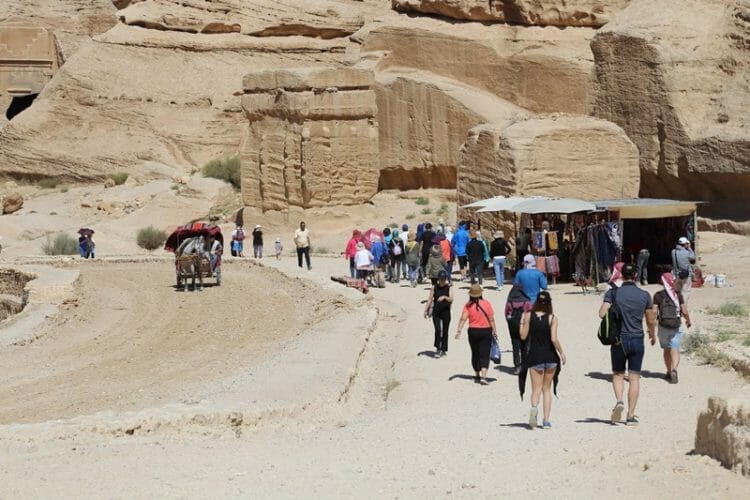
A trip to Jordan simply isn’t complete without a visit to Petra. You could read a hundred guidebooks about the various landmarks in Petra, or see a thousand photos of The Treasury or The Royal Tombs; but nothing can prepare you for the overwhelming flood of awe and amazement when you catch your first glimpse of the Treasury through the Siq or make your way down the Colonnaded Street.
If you are planning to travel to Petra, read on for essential Jordan travel tips, how to get there, the best things to do and see in Petra in 1 day and more.
Visiting Jordan for the first time? Click here for an easy 7 day Jordan itinerary or head on over here for even more destination guides!
Quick tips for your first trip to Jordan
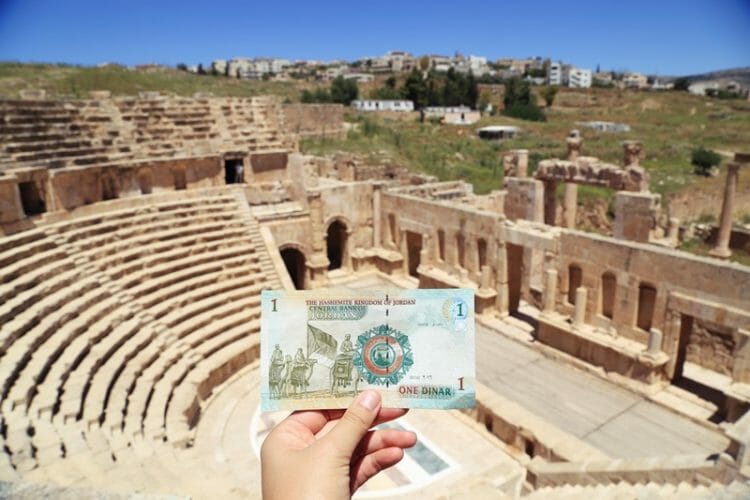
✈️ The major international airport is located in Amman – the Queen Alia International Airport (airport code AMM). The best way to get to Petra is to fly into Amman. From there, the drive will take approximately 3 hours.
🛂 You need a visa to enter Jordan, but the good news is that citizens from a large number of countries can buy a visa on arrival in Jordan for 40 JOD (approximately US$56). You can pay this fee by credit card at the airport.
🎟️ Alternatively, if you plan on staying in Jordan for more than 3 nights then you should consider purchasing the Jordan Pass. A Jordan Pass grants you entry into over 40 attractions across Jordan, including Petra. You can choose the “Jordan Wanderer” Jordan Pass which costs 70 JOD (US$99) and includes a 1-day visit to Petra, the “Jordan Explorer” which costs 75 JOD (US$106) which includes a 2-day visit to Petra or the “Jordan Expert” which costs 80 JOD (US$113) which includes a 3-day visit to Petra. If you do not purchase the Jordan Pass then the standalone 1-day ticket for Petra costs 50 JOD (US$70), 2-day ticket costs 55 JOD and 3-day ticket costs 60 JOD. Read more about Petra entrance prices here or click here to read my review of the Jordan Pass.
💱 The Jordanian Dinar (JOD) is used in the country and the rate is approximately 1 JOD: US$1.4, or 1 JOD: 1.24 Euros. Cash is king so make sure you have a few small denomination notes handy for tipping.
📱 Stay connected by purchasing a SIM card at the airport in Amman – it will cost you approximately 11 JOD for 10 GB of data, and the SIM card is valid for 10 days.
🌤️ The weather in Petra does fluctuate through the year. Temperatures can reach over 30 degrees Celsius (86 Fahrenheit) from May to October, and fall below 10 degrees Celsius during November to February. The park is fairly exposed so you’ll need to dress appropriately – that means plenty of sunscreen and a hat in summer, and warm clothes during the winter.
🗓️ Tourism numbers in Jordan are manageable and nothing like the crowded sites in places like Italy or Greece – we found that none of the attractions were overwhelmingly busy in May. The best time to visit Petra tends to be when the weather is milder from March to May or September to November.
🌐 Arabic is the most spoken language in Jordan, and most people, especially those in hospitality or food & beverage, speak English very well so you shouldn’t have a problem with communication.
You might also like: 11 important things to know before you travel to Jordan
Is it safe to visit Jordan?
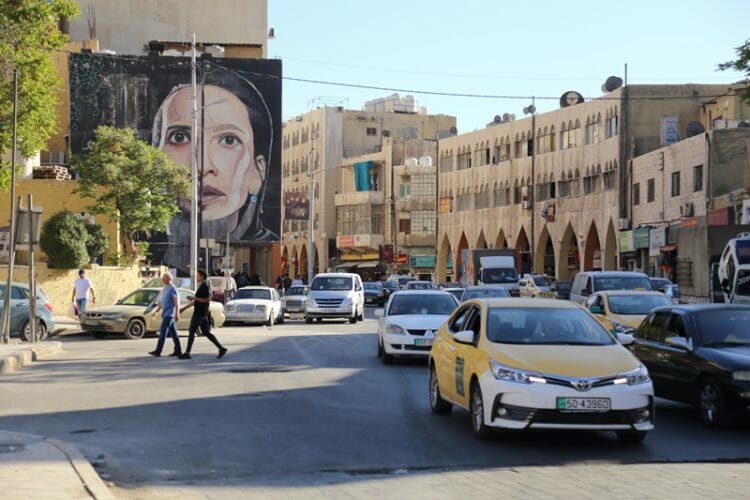
In my personal experience, Jordanians are hospitable, friendly, culturally open-minded and very helpful. We did not experience any pushiness in other parts of Jordan, but there was a minor amount of hassling from camel, horse and donkey carriage-drivers and souvenir-sellers within the Petra Archaeological Park. Usually, a simple “no, thank you” will suffice.
Though Jordan shares borders with Iraq and Syria, the country has been relatively immune to the instability plaguing the region. Read more about safety and security in Jordan here. If you are visiting Jordan, you should stay at hotels with a visible security presence, be alert to possible threats (especially at tourist locations and religious sites) and monitor local and social media for updates.
Visiting Petra in Jordan during Ramadan
Ramadan is a holy month observed by Muslims. The dates of observance varies according to the Islamic lunar calendar. During Ramadan, Muslims fast from dawn to sunset, and alcohol is not sold (except in some larger hotels and restaurants).
Some places may switch to a special Ramadan menu, and shops and even tourist attractions may close early. In general, you should try to avoid eating and drinking (even water) in public as a sign of respect during Ramadan. However, it would not be advisable to stop hydrating and drinking water if you are exploring Petra, especially if you are getting around on foot.
During Ramadan, the Petra Archaeological City opens at 7 AM and closes at 4 PM.
How to get to Petra
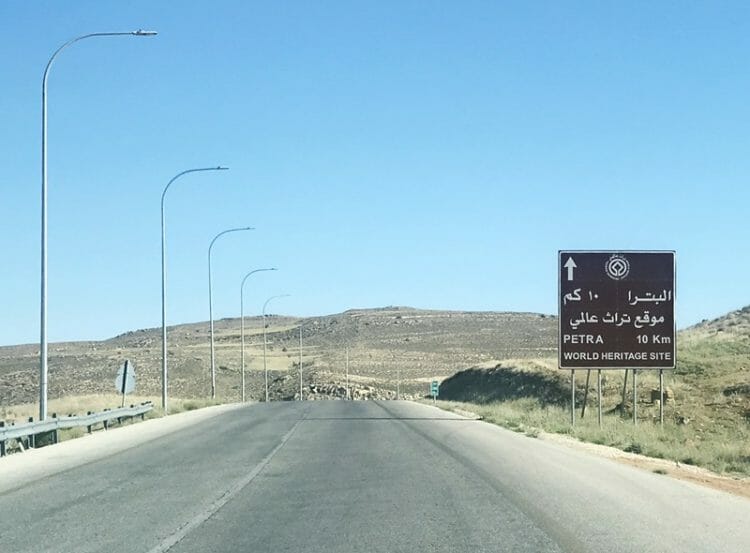
From Amman to Petra, the drive will take you approximately 3 hours. From Aqaba to Petra, expect to drive for 2 hours, and if you are traveling to Petra from Wadi Rum it will take just over an hour by car.
The easiest way to get around Jordan is by car, so we rented our trusty Toyota through Budget – expect to pay US$30-40 USD per day, and extra for any additional drivers. The best thing about renting through Budget is that there is a very low excess (AKA deductible) of 350 JOD as their cars already have a basic level of insurance.
You’ll need to show your local driver’s license, and they might ask if you also have an international license. Make sure you check the car with an attendant from the rental company to make a note of any existing scratches and damage, and take your own photos and video so you have a record in the event of any disputes. Click here to check for current car rental rates!
Looking for the best prices for rental car companies around the world? Click here to book your rental car ahead of your trip. Bookings can be cancelled or amended if your plans change!
Petra is located within a town called Wadi Musa, and driving around Wadi Musa is easy if you have access to Google Maps. There are several one-way roads and the occasional spot of traffic, but it’s manageable otherwise. You can park your car 100 meters up the road from the Petra Visitor Center (the main entrance to Petra Archaeological Park) for 3 JOD – look for the parking lot with tons of tour buses. Most hotels offer free on-site parking.
If you are trying to get to Petra by public transport, you can take the JETT Bus from Abdali station in Amman or by public minibuses. A taxi from Amman to Wadi Musa/Petra will cost approximately 70 JOD (US$100).
Where to stay in Petra
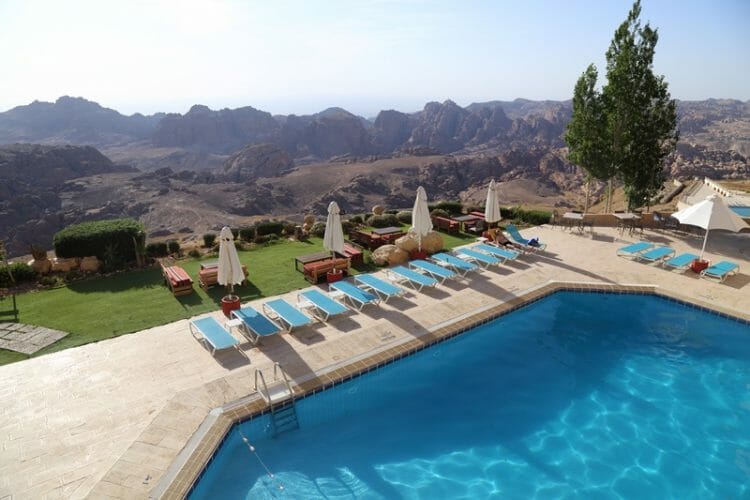
Wadi Musa is the nearest town to the archaeological site of Petra. When visiting Petra in Jordan, there are a number of hotel options to suit all budgets, but if you are looking for an upscale hotel with excellent facilities and service then I highly recommend the Petra Marriott.
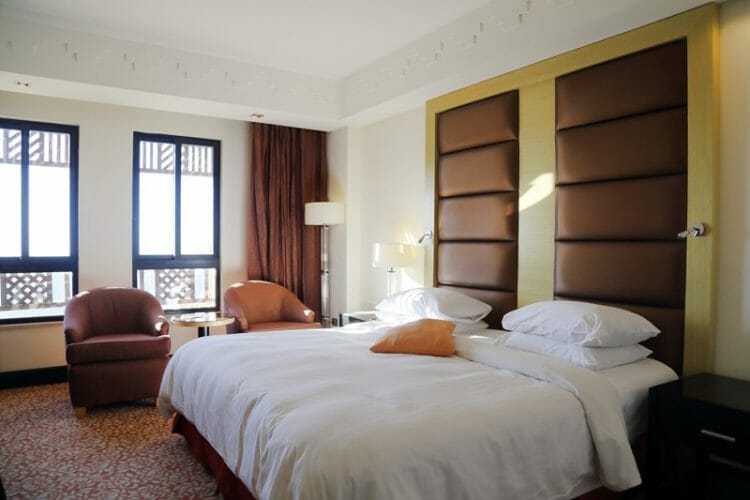
Though the décor is a little dated at the Petra Marriott, the rooms are spacious and comfortable, and we were upgraded to one with a stunning view. The breakfast and dinner buffets are plentiful, fresh and reasonably priced, and the sunset view from the pool can’t be beat.
The staff hospitality is extraordinary at the Petra Marriott – everyone went above and beyond to make our stay enjoyable, and the hotel is just 5 minutes away by car from the Petra Visitor Centre. Though many people opt to stay on the main strip, we actually appreciated being far from the crowds. The Petra Marriott is one of the best hotels in Petra – click here to see current rates and availability.
Looking for more options for where to stay in Petra? Based on extensive research we would also consider staying at these properties, or you can also check out some other highly rated hotels in Wadi Musa here.
Mövenpick Resort Petra: If you prefer to stay within walking distance of the Petra entrance then you really can’t get closer than this. The 5-star Mövenpick Petra is directly across the street from the Petra Visitor Centre, and boasts several on-site restaurants and facilities. Reviewers love the rooftop restaurant and helpful staff. Click here to check rates and availability at Mövenpick Resort Petra.
H Luxury Hotel: A brand new luxury hotel in Petra, H Luxury offers modern and comfortable rooms about 5-minutes away on foot from the Petra Visitor Centre. There is a rooftop terrace and indoor pool, and previous guests rave about the excellent service and value-for-money. Click here to check rates and availability at H Luxury Hotel.
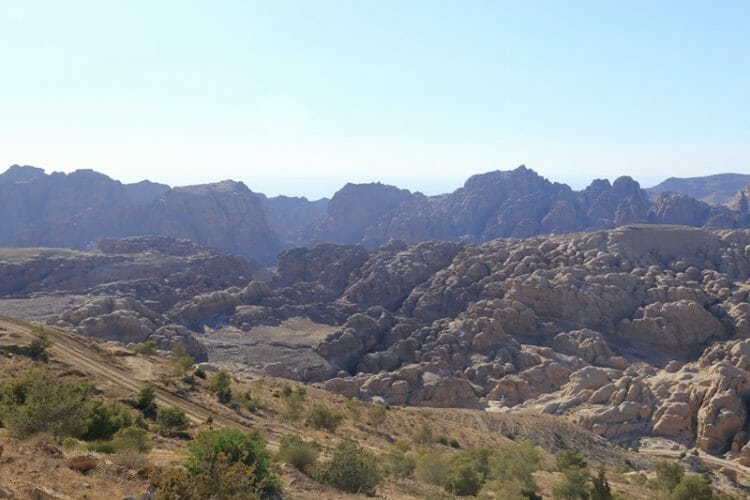
Wondering how long to stay in Petra? I recommend 1 day in Petra at the very minimum, or 2 nights if you plan on doing “Petra by Night”. Those who want to fully explore the entirety of the park and its various trails can stay for 3 days or more.
What to bring to Petra
- A printed or e-copy of the Jordan Pass if you purchased one
- Your passport (it will be checked if you are using a Jordan Pass)
- Cash (for snacks and extra bottles of water)
- As much water as you can carry in your refillable bottle
- Suncreen
- Hat
- A handheld fan
- Your camera – I opted for a 24-70 mm lens but a phone camera works fine during the day as well. You’ll want to bring a small tripod if you attend “Petra By Night”
There are a handful of bathrooms and small restaurants/shops within Petra Archaeological Park.
What to wear to Petra
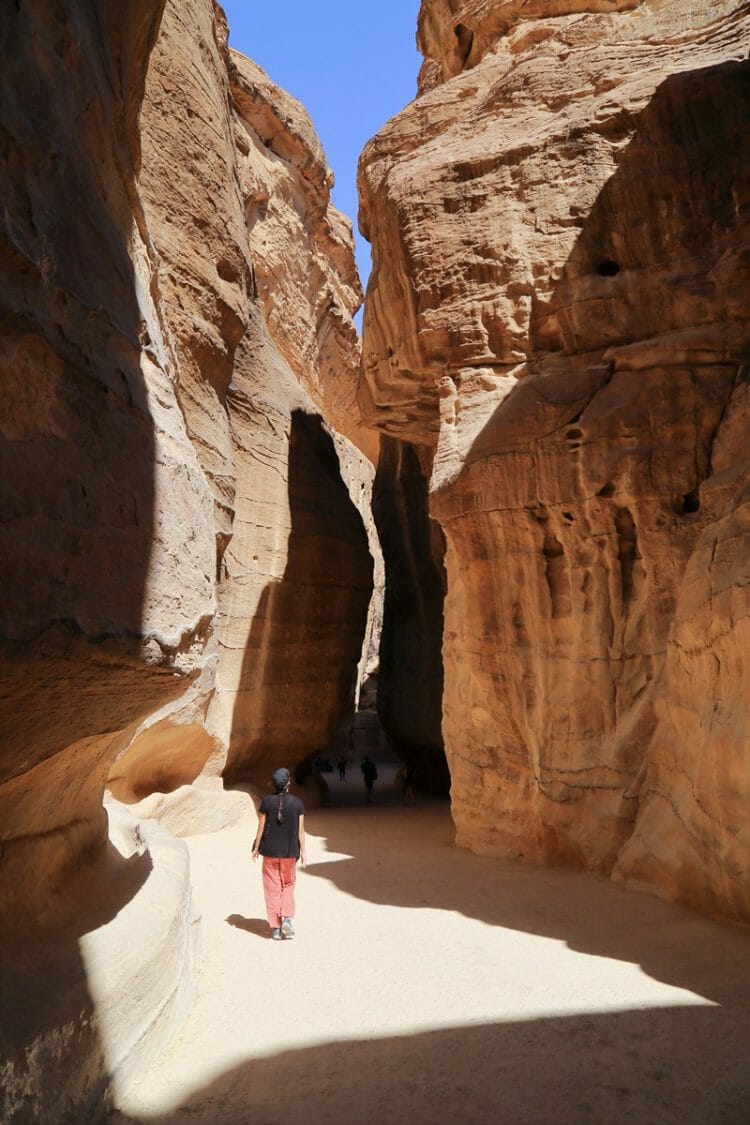
The pathways and dirt roads within the Petra Archaeological Park can be pebbly, uneven and dusty. You absolutely need to wear proper walking shoes, leave the flip flops, wedges and heels at home. Though most people in Jordan are Muslim, we did not find that Jordan was extremely conservative.
You will find that many tourists wear shorts and sleeveless tops in public, but I would recommend that as a sign of respect and cultural sensitivity you are mindful of what you wear in Petra and Jordan as a whole. I wore loose pants, a tank top and short-sleeved cardigan to cover my shoulders. You should try to wear breathable clothing that’s easy to walk in.
How to get around Petra
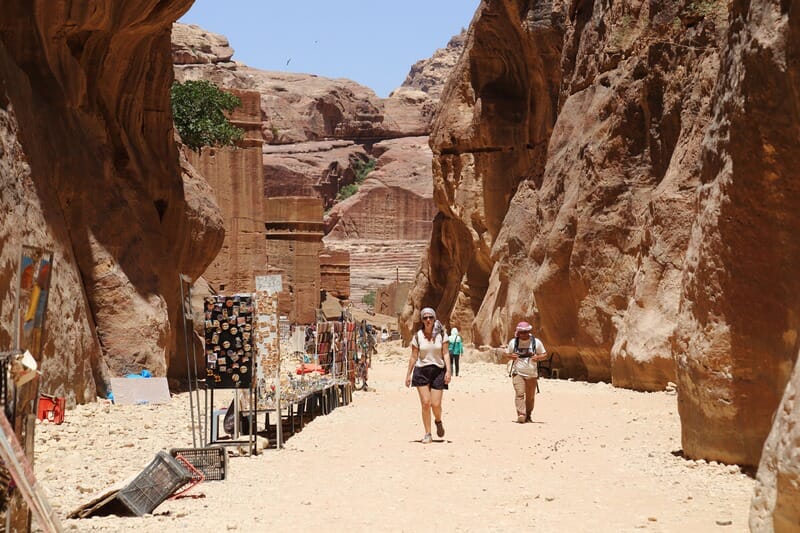
On foot: Most people get around Petra on foot. You need solid walking shoes and plenty of water.
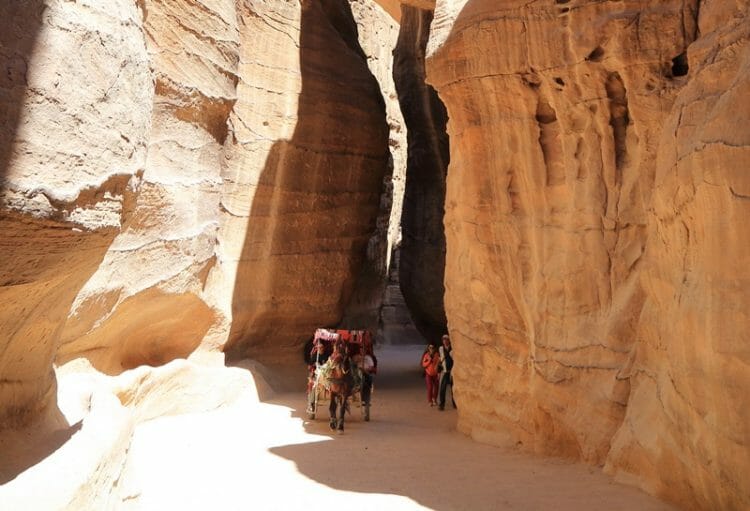
By horse carriage, donkey or camel: Carriages were introduced for people who are unable to walk all the way to the Treasury, and horses, camels and donkeys have long been used as working animals in this region.
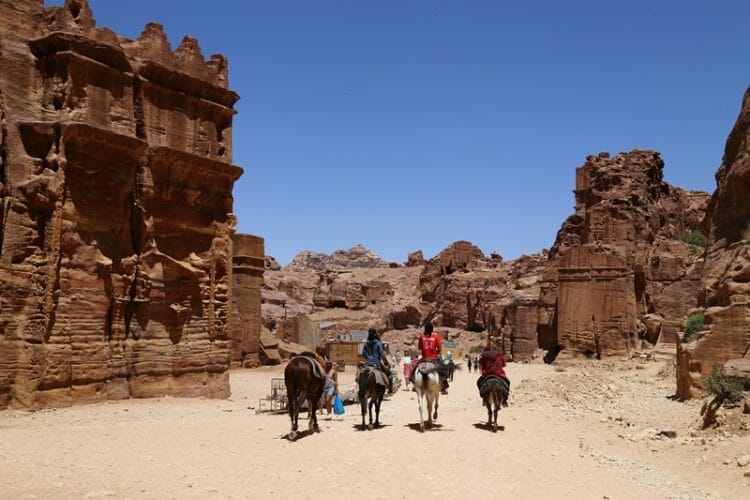
That being said, during our 7-8 hour visit to Petra I don’t recall seeing any of the animals being provided with water within the park (when they were outside the stables), and many were tied up in the sweltering heat with no shade. We also saw horse carriage after horse carriage and camel after camel ferrying people back and forth, all day long.
I vividly remember seeing this one same carriage and driver at least 3 to 4 times in the park, and wondering whether the horse had time to rest between trips. I did not see the stables, so can not speak to the conditions under which the animals are kept, but the authorities have pledged to intensify efforts to improve the conditions of animal welfare at Petra (and even encourages visitors to report any suspected abuse).
It is important to bear in mind that some people depend on these working animals for their livelihood. A community leader from Petra told The Jordan Times that around 90 per cent of Um Sayhoun’s population (the village beside Petra) depend on tourism as their only income. Another tourist guide also pointed out that donkeys are the only means to carry water and goods to the shops at the Monastery and to other monuments in Petra.
If you have mobility issues and need some help getting around Petra Archaeological Park, I recommend choosing a carriage that is operated by an adult rider/driver, taking a close look at whether the animal has any exposed wounds, and seeing whether it has access to water and shade between rides. If you are able to and do not experience mobility issues, I would recommend that you reconsider using the horse carriages, donkeys and camels in Petra.
By golf buggy: For those with mobility issues, not to worry: there also appears to be an electric golf buggy for hire in Petra from the visitor center.
Petra opening hours
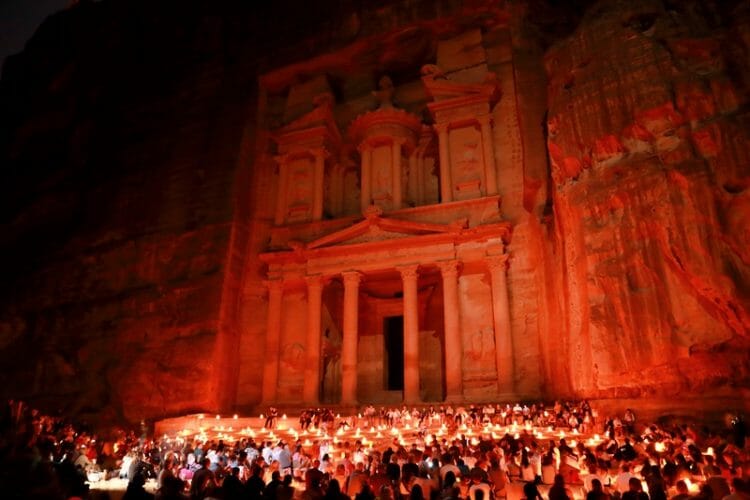
The ancient site of Petra and its Visitor Center are open to visitors daily from 6 AM to 6 PM during the summer and 6 AM to 4 PM in the winter. As I mentioned earlier, the opening times may vary during the month of Ramadan.
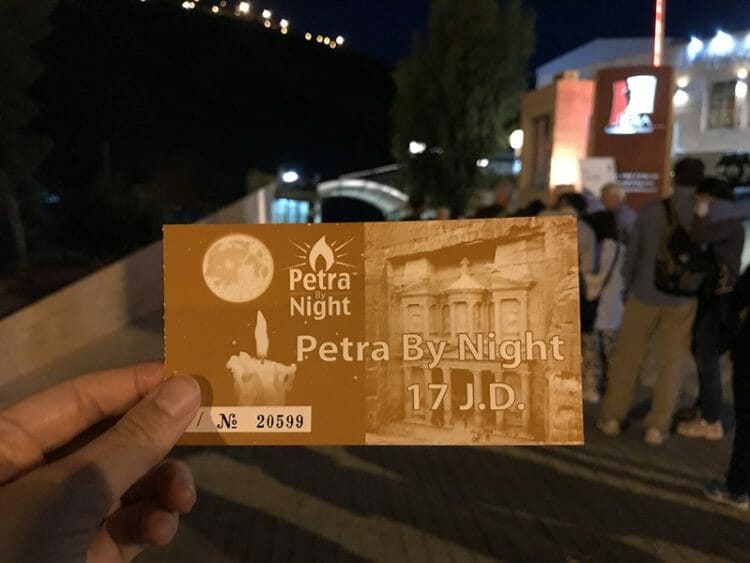
Though Petra Archaeological Park closes in the early evening, the park does open at night 3 times a week on Monday, Wednesday and Thursday. The thrice-weekly “Petra By Night” show is a magical experience not to be skipped if you can time your visit properly. It is an incredible way to see part of the rock city and starts with a candlelit walk along the entire Siq to the Treasury, where musical performances are held under the moonlight and shimmering stars.
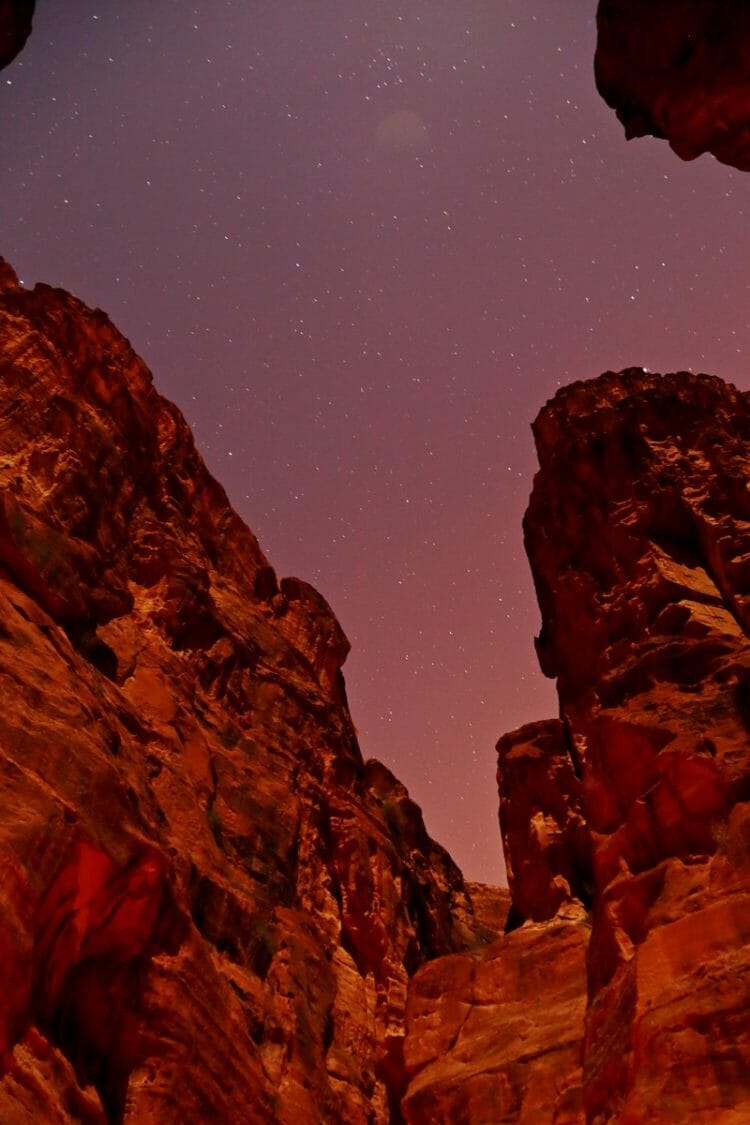
There is no limit to the number of tickets sold for Petra By Night, and you can not book a ticket in advance. You also need to have a valid ticket for regular entry into Petra (or your Jordan Pass). Petra By Night begins at 8:30 PM at the Petra Visitor Center, and you should plan to arrive 30 minutes early to sort out your tickets.
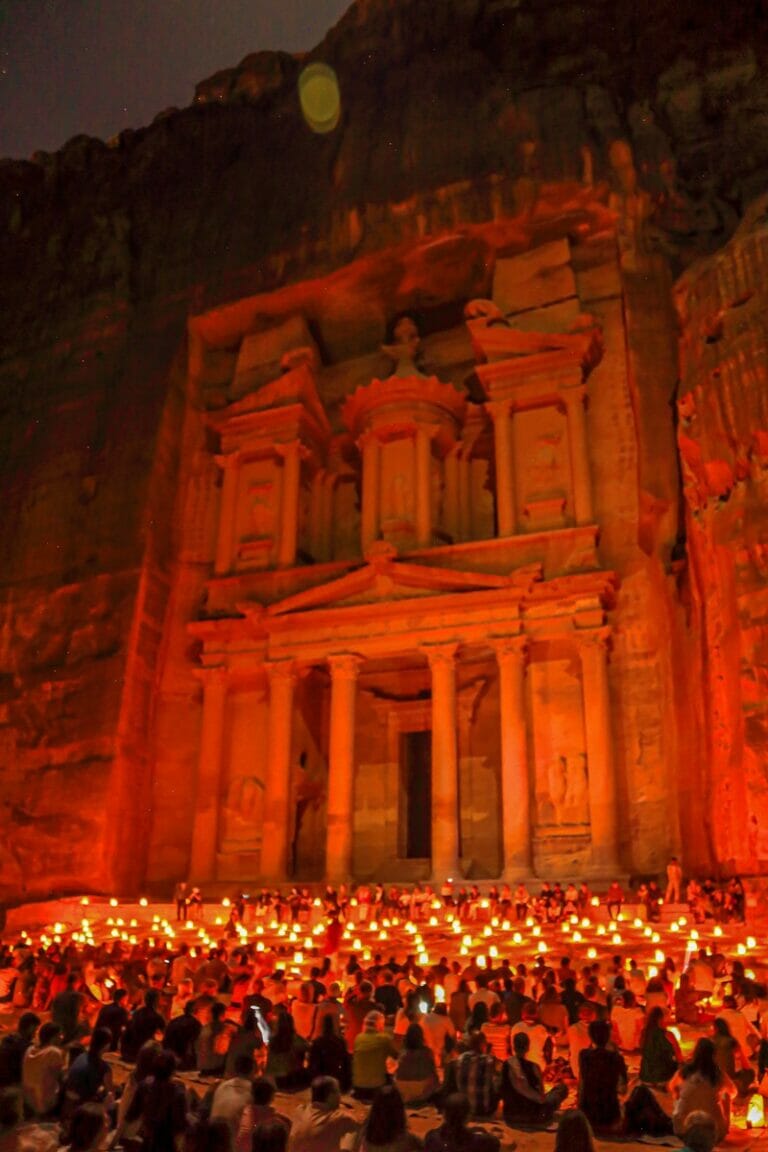
The event finishes at around 10:30 PM, but performances finish and crowds start to clear out of the Treasury by about 9:30, 9:45 PM. Tickets cost 17 JOD per person and is not included in your Petra entrance ticket nor is it included in the Jordan Pass.
You might also like: Jordan Pass Review – Is It Worth Purchasing?
What to see in Petra
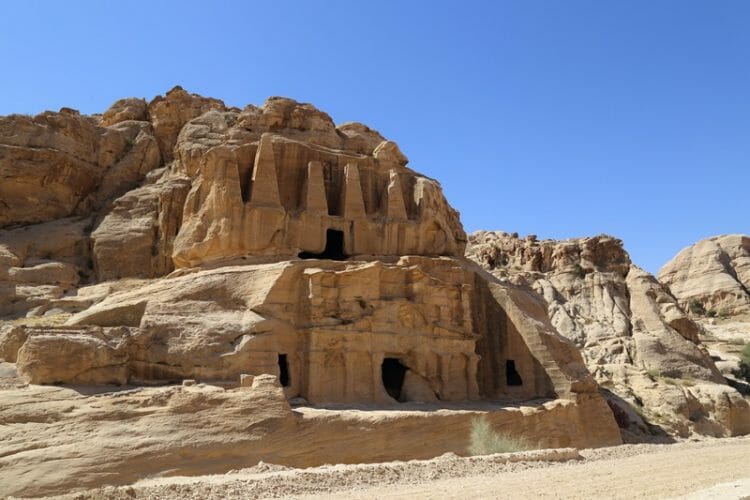
Petra Archaeological Park covers an area of 264,000 square meters…it would take weeks to explore the entirety of the complex. There are various trails that you can take, with the Main Trail starting at the Petra Visitor Center in the heart of Wadi Musa.
Click here for a high-resolution map of Petra including trail routes, approximate round-trip walking distances and durations as well as the level of intensity of each trail, or click here to read more about each trail in Petra Archaeological Park.
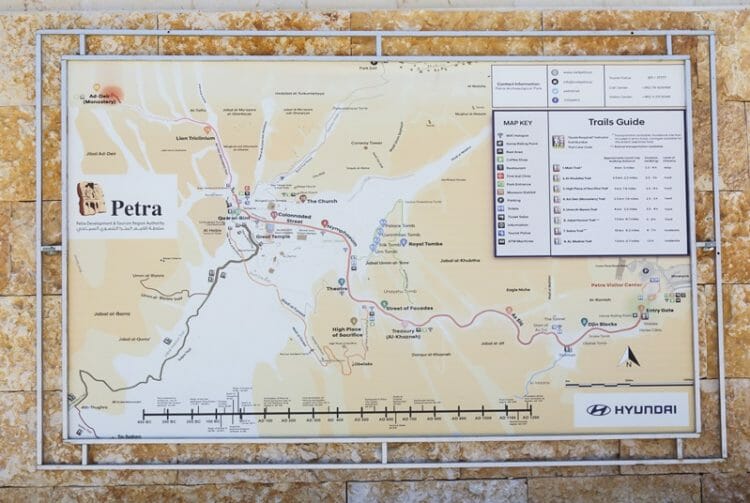
Though The Treasury is often hailed as the face of Petra, there are actually tons of breathtaking monuments to visit: here are some of the key highlights and places to see in Petra!
1. The Siq
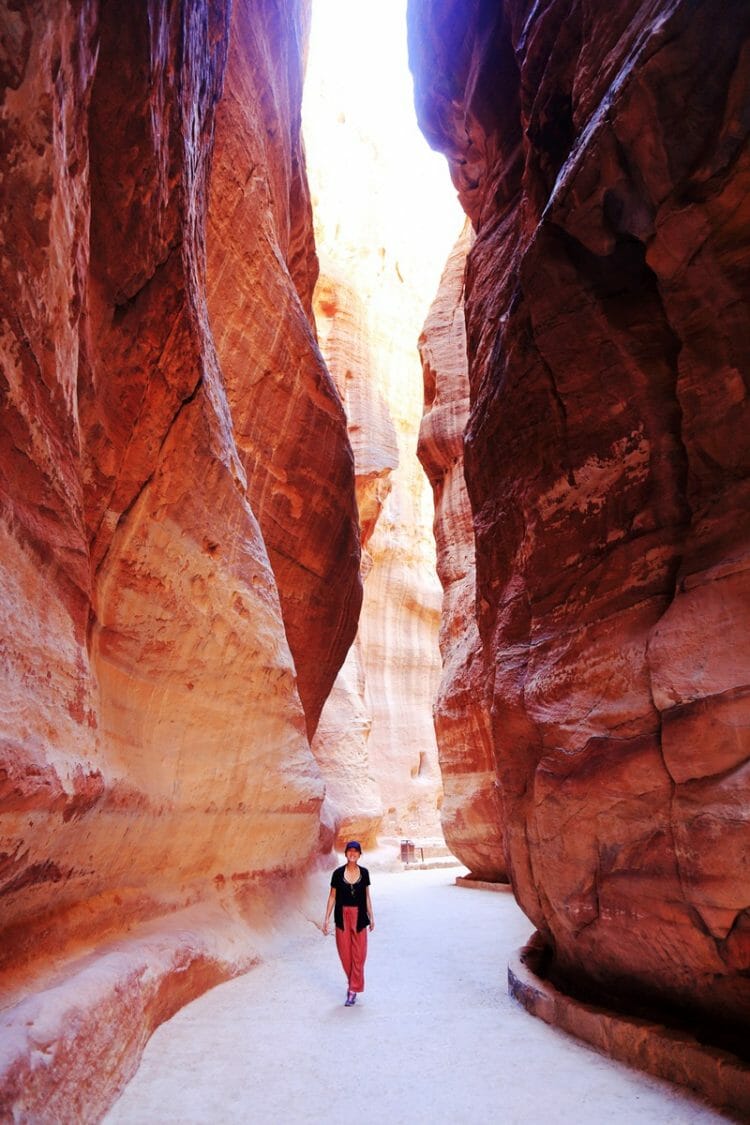
From the main entrance at the Petra Visitor Center, a 10 to 15-minute walk will take you to the opening of the Siq. The narrow gorge is 1.2 kilometres long and was formed from a splitting of the mountain. The rock canal is 3 to 12 meters in width and reaches up to 80 meters in height.
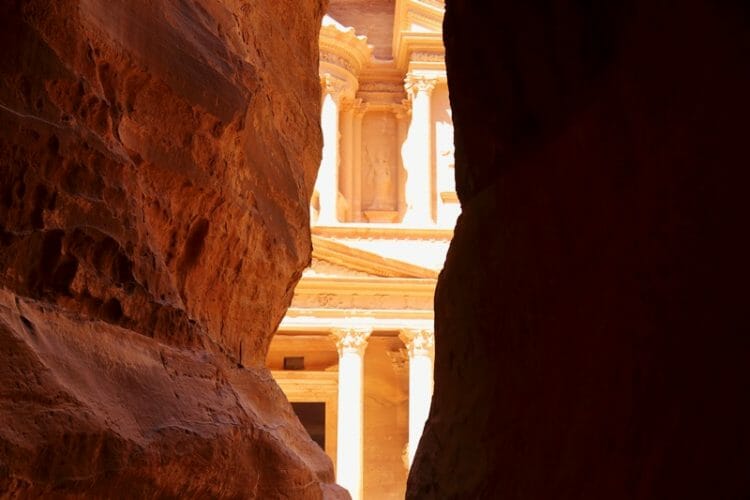
The dramatic grooves and waves lead visitors into the heart of Petra and the most famous attraction, The Treasury.
Wondering where to stay in Petra? We recommend Petra Marriott, one of the best luxury hotels near Petra Archaeological Park and a 5-minute drive from the main entrance of the Petra site. Click here to check availability at Petra Marriott.
Looking for more options for where to stay in Petra? Based on positive online reviews and feedback, we would also consider staying at these properties, or you can also check out some other highly rated hotels in Wadi Musa here.
Mövenpick Resort Petra: If you prefer to stay within walking distance of the Petra entrance then you really can’t get closer the 5-star Mövenpick Petra. It is located directly across the street from the Petra main entrance. Click here to check rates and availability at Mövenpick Resort Petra.
H Luxury Hotel: A brand new boutique hotel in Petra, H Luxury offers modern and comfortable rooms about a 5-minute walk from the Petra entrance. Click here to check rates and availability at H Luxury Hotel.
2. The Treasury
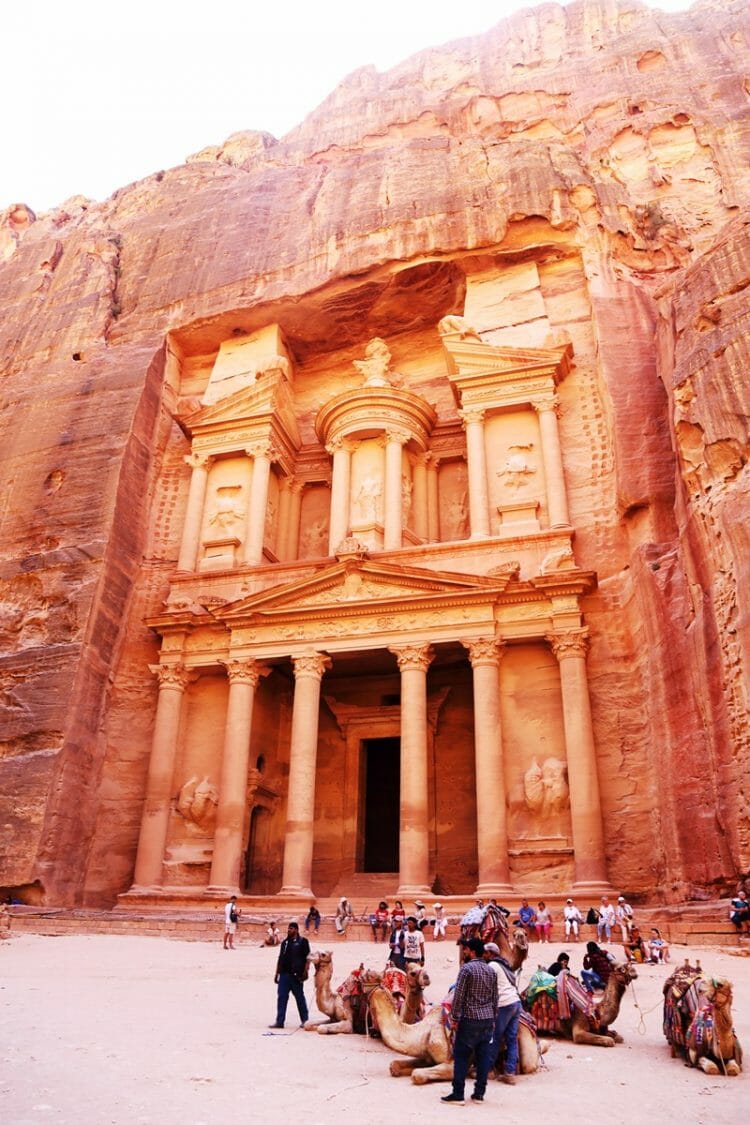
The Treasury, or Al Khazna, is a towering facade carved into the mountain and is perhaps Petra’s most famous landmark. It stands almost 40 meters high and is crowned by a funerary urn, which according to local legend conceals a pharaoh’s treasure.
It was probably constructed in the 1st century B.C., and its function is unclear – some archaeologists believe it to be a temple, while others think it was a place to store documents. However, the most recent excavation unearthed a graveyard beneath the Treasury. You can not enter The Treasury.
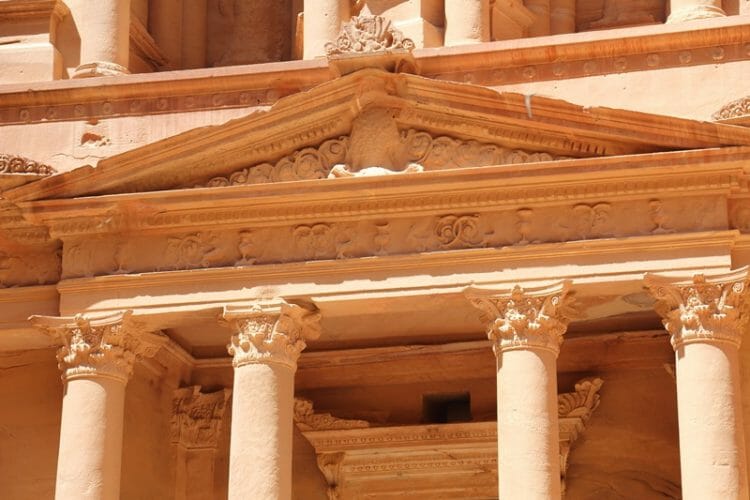
Some people stop here and don’t explore the rest of Petra – if that is what you’re planning to do, then you should expect to walk approximately 4.2 kilometres (return) between the Petra Visitor Center and The Treasury. It will take you anywhere between 30 minutes to an hour each way.
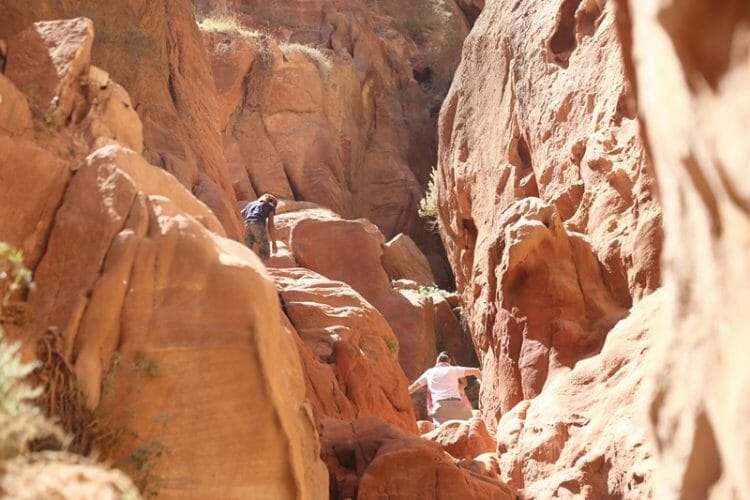
There are several viewpoints in Petra where you can see the Treasury from above. Though you COULD try to find your own way there, you might get hassled by local guides who make a living off taking tourists to and from these viewpoints. When we arrived at the Treasury, we were approached by a guy who offered to take us to the “secret Treasury viewpoint” for 7 JOD per person.
After a bit of umming and ahing, we agreed and set out with a group of 6 others to climb to one of the Petra Treasury viewpoints. The trek was moderately challenging and involved some rock climbing, but only took 15 to 20 minutes. At the Treasury viewpoint, you can buy tea or water from the shopkeeper – if you don’t purchase anything, you will be asked to pay 1 JOD per person to take a photo there.
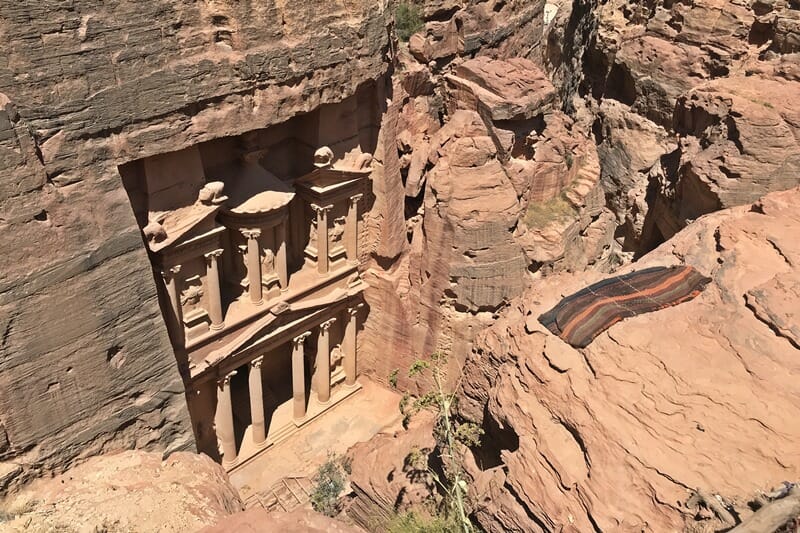
Though I am diligent about researching trips ahead of time, I did not know that these “shortcut” hikes to the viewpoints are illegal. I feel absolutely terrible to have partaken and have since learned that these illegal hikes contribute to significant deterioration of the sandstone in Petra. You can read more about the impact of tourism development on Petra and the local communities here. I would therefore recommend that you stick to the marked trails in Petra.
Ready to book your Petra trip? We enjoyed our stay at Petra Marriott, one of the best luxury hotels near Petra Archaeological Park and a 5-minute drive from the Petra Visitor Centre. Click here to check availability at Petra Marriott.
Looking for more options for where to stay in Petra? Based on positive online reviews and feedback, we would also consider staying at these properties, or you can also check out some other highly rated hotels in Wadi Musa here.
Mövenpick Resort Petra: If you prefer to stay within walking distance of the Petra entrance then you really can’t get closer than this. The 5-star Mövenpick Petra is directly across the street from the Petra Visitor Centre. Click here to check rates and availability at Mövenpick Resort Petra.
H Luxury Hotel: A brand new luxury hotel in Petra, H Luxury offers modern and comfortable rooms about 5-minutes away on foot from the Petra Visitor Centre. Click here to check rates and availability at H Luxury Hotel.
3. The Theatre
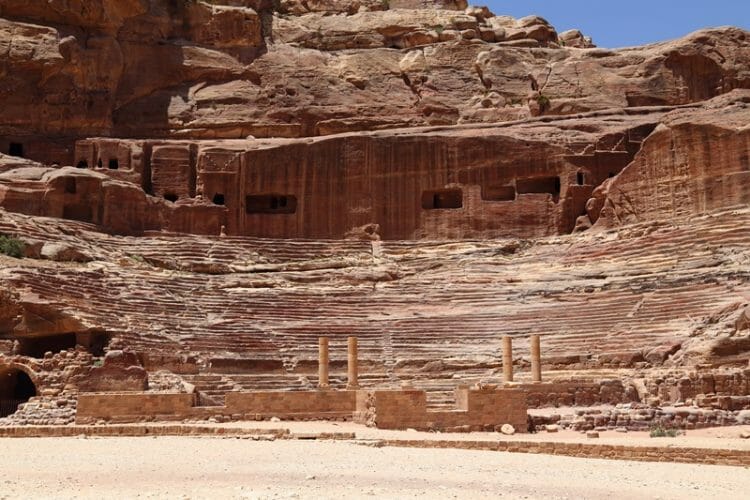
Walk to the right of The Treasury along the Street of Facades and you will find The Theatre. Carved into the side of the mountain at the foot of the High Place of Sacrifice, the Theatre could accommodate 4000 spectators and is the only one of its kind in the world.
4. The Royal Tombs
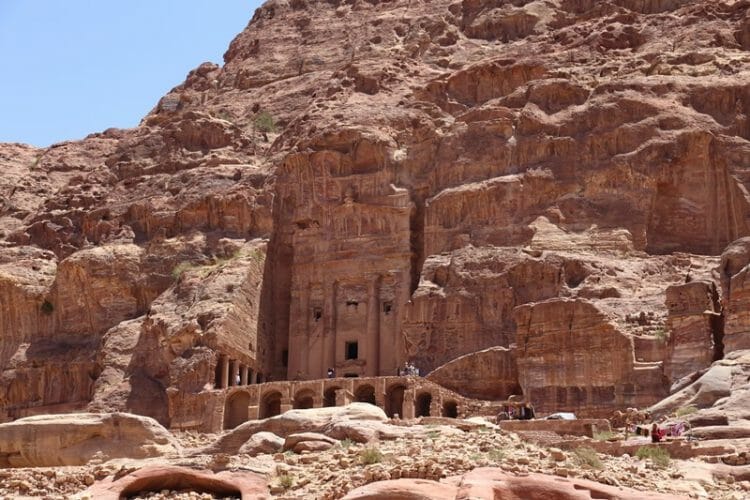
Further past The Theatre are the Royal Tombs that overlook the city. The four tombs are the Urn Tomb, constructed around 70 A.D. with niches that open into small burial chambers, the Silk Tomb featuring multi-coloured rock on its facade, the Corinthian Tomb with water basins for cleansing rituals, and the Palace Tomb with a five-storey facade and burial rooms.
5. The Great Temple
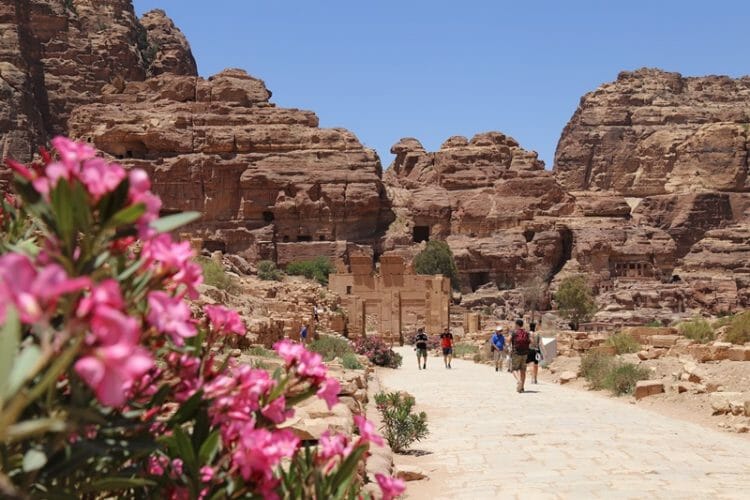
The Great Temple Complex represents one of the major archaeological and architectural components of central Petra. The complex covers approximately 6000 square metres and features massive 15-metre-tall columns. It’s thought that the sanctuary was constructed by the end of the 1st century B.C. by the Nabataeans.
Ready to book your Petra visit? We stayed at and recommend Petra Marriott, a fabulous luxury hotel near Petra Archaeological Park with a beautiful pool overlooking the valleys. It offered up stunning sunset views and we enjoyed the buffet selection. Click here to check availability at Petra Marriott.
Looking for more options for where to stay in Petra? Based on positive online reviews and feedback, we would also consider staying at these properties, or you can also check out some other highly rated hotels in Wadi Musa here.
Mövenpick Resort Petra: If you prefer to stay within walking distance of the Petra entrance then you really can’t get closer the 5-star Mövenpick Petra. It is located directly across the street from the Petra main entrance. Click here to check rates and availability at Mövenpick Resort Petra.
H Luxury Hotel: A brand new boutique hotel in Petra, H Luxury offers modern and comfortable rooms about a 5-minute walk from the Petra entrance. Click here to check rates and availability at H Luxury Hotel.
6. The Monastery
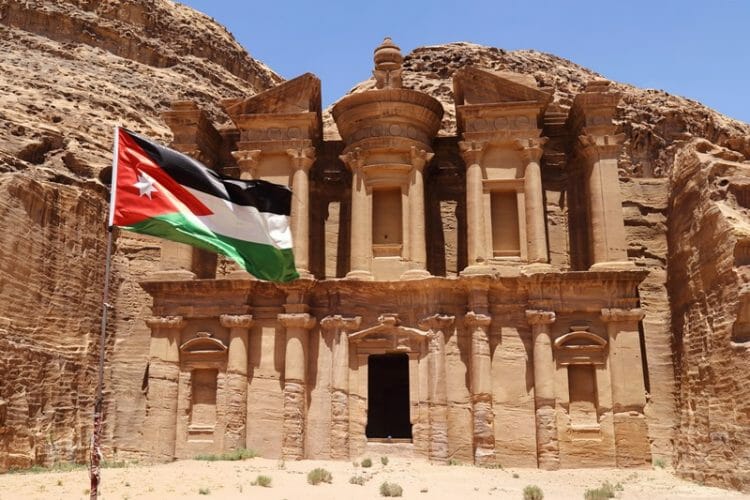
Also known as Ad Deir, The Monastery is another one of Petra’s crown jewels and is one of its largest monuments standing at 47 metres wide and 48.3 metres tall. The space was used for the meetings of religious associations and was later re-used as a Christian chapel. The Monastery dates back to the early 2nd century A.D., and is one of the most popular places to visit in Petra.
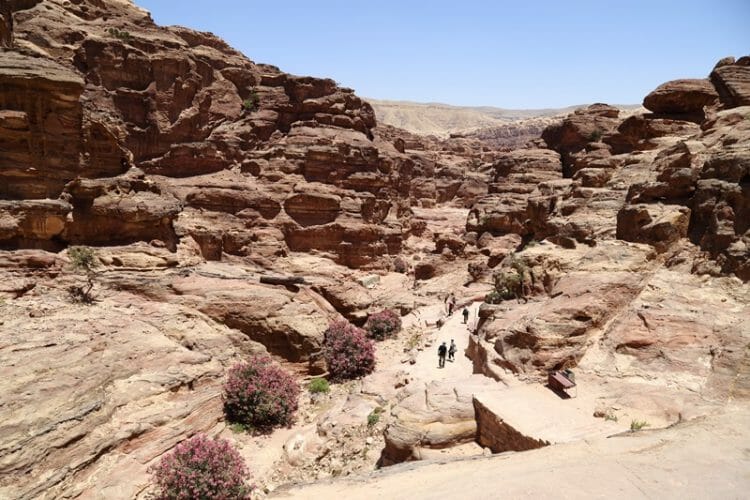
There are 2 ways to get to the Monastery: from the main trail, or via the “back route” from Little Petra. We took the main trail – from the visitor center, you take the main trail (approximately 8 kilometres) followed by the Ad Deir trail (approximately 2.5 kilometres) which means you walk 10+ kilometres each way.
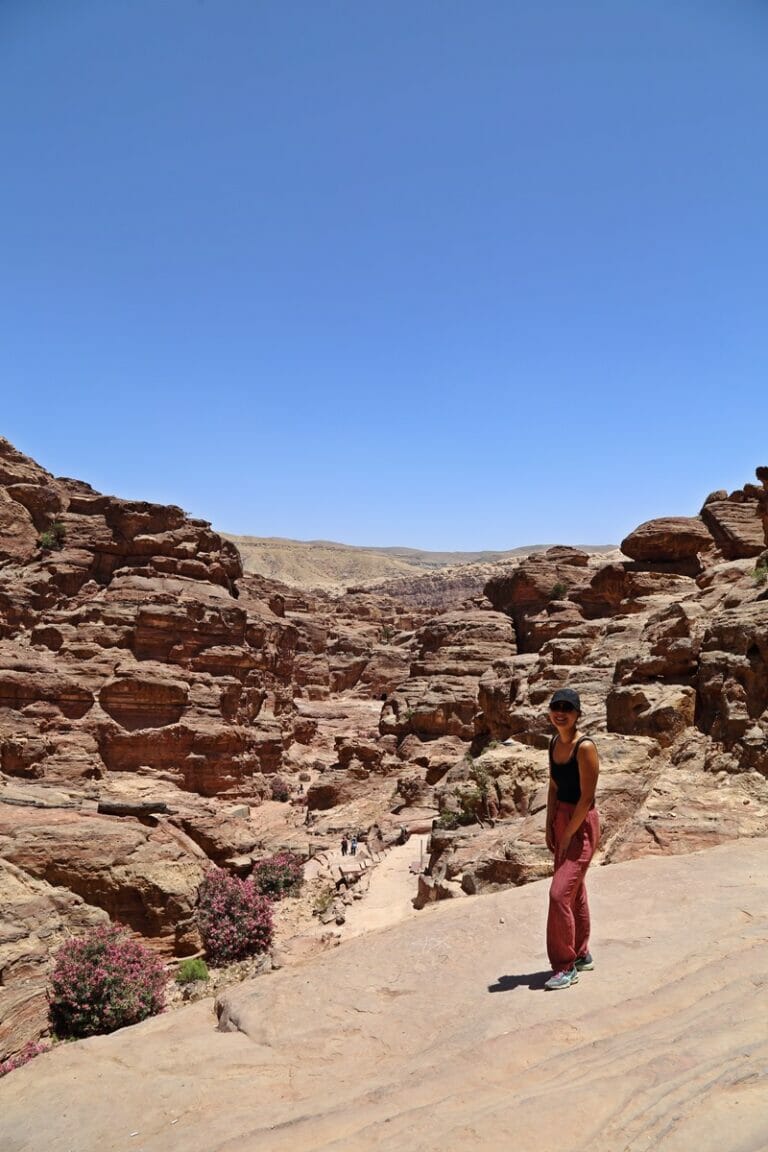
If you are planning on taking the main trail to the Monastery, you will end up spending 7-8 hours walking in Petra. The trail is mostly flat until you reach the Ad Deir trail which involves an uphill climb and 800-plus steps. This trailhead begins behind the Basin Restaurant.
Alternatively, if you have more than 1 day in Petra then you can consider visiting the Monastery from the back trail. For this trail you will need to go with a licensed guide from the Petra Visitor Center.
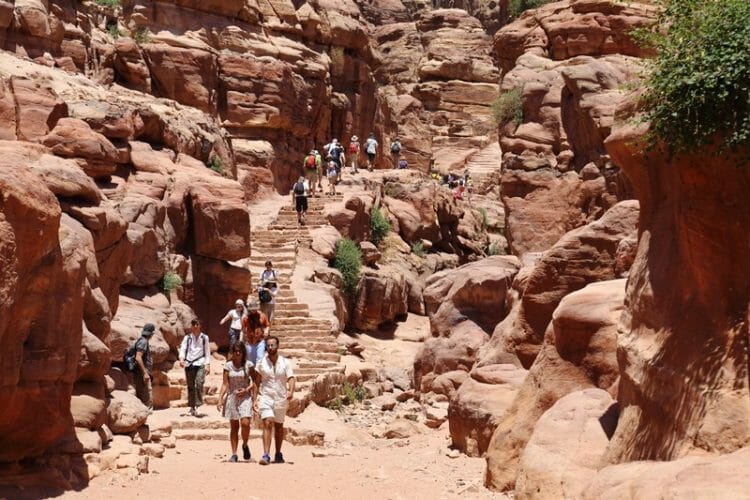
Personally, I really struggled with the heat when we visited Petra in May. The 800 steps to the Monastery damn near killed me, and I was not in the best mood when we finally arrived at the monument. Though it’s sometimes touted as the “quieter” or “less visited” version of the Treasury, there were still hordes of tourists at the Monastery – not exactly “off the beaten track”.
Coupled with the fact that the Ad Deir trail is covered with donkey and mule manure (you can imagine how that smells in the sweltering heat), it’s not exactly the most pleasant hike!
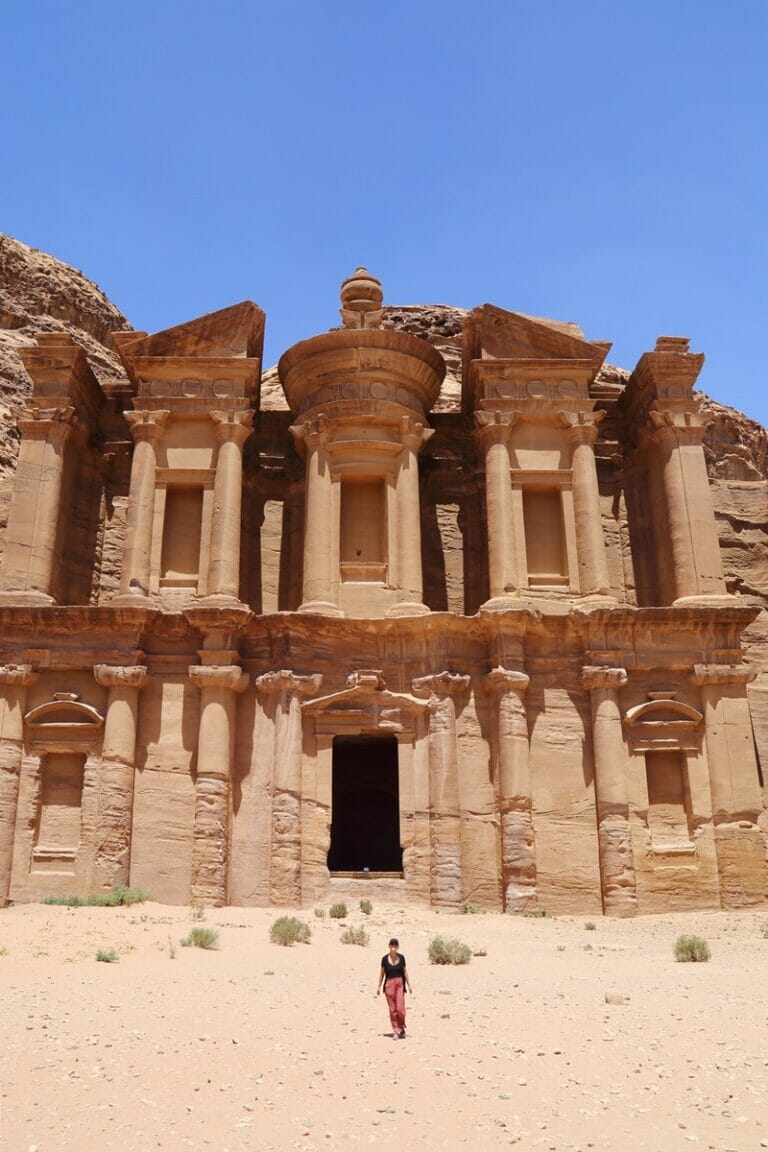
Would I recommend that you visit The Monastery from the main trail? Only if you are in good physical shape, have plenty of water and have your heart set on visiting Ad Deir. Otherwise, I might recommend turning back after visiting The Great Temple Complex or continuing on if the weather is more forgiving.
Where to go after Petra
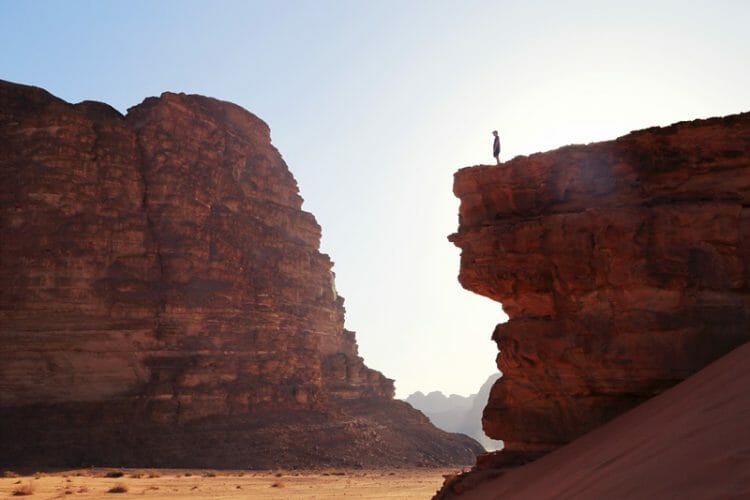
Traveling through Jordan for a few more days and don’t know where to go? If you’re traveling from north to south you can get from Petra to Wadi Rum in just over an hour, and from Petra to Aqaba in about 2 hours. If you’re traveling from south to north you can head from Petra to Amman in 3 hours. Head on over here to read my travel guide to Amman.
Ready to book your stay in Petra? I recommend staying at the Petra Marriott, one of the best luxury hotels near Petra Archaeological Park. Click here to check availability at Petra Marriott. You may also consider staying at Mövenpick Resort Petra (a 5-star hotel across the street from the Petra Archaeological Park entrance) or H Luxury Hotel (a brand new boutique hotel in the heart of Wadi Musa town). you can also check out some other highly rated hotels in Wadi Musa here.
Heading to Jordan? You might also find these guides helpful:
- Planning a trip to Jordan? Read this first for the top things to know before you travel to Jordan
- Consider purchasing the Jordan Pass if you are exploring the country and visiting multiple heritage sites. Here is my Jordan Pass review
- Starting your trip in Amman? Read my Amman city guide and make sure you plan a day trip to the ruins of Jerash
- You can get a good taste of what Jordan has to offer in just 7 days. Click here to read my easy 1 week Jordan itinerary
- Thinking about visiting Egypt as well? You might want to check out this 2 week Egypt + Jordan itinerary for some ideas
I hope you found this Petra itinerary helpful. Are you planning a trip to the lost city of Petra? Comment below with any questions and I’ll do my best to answer them!
Pin this for later!
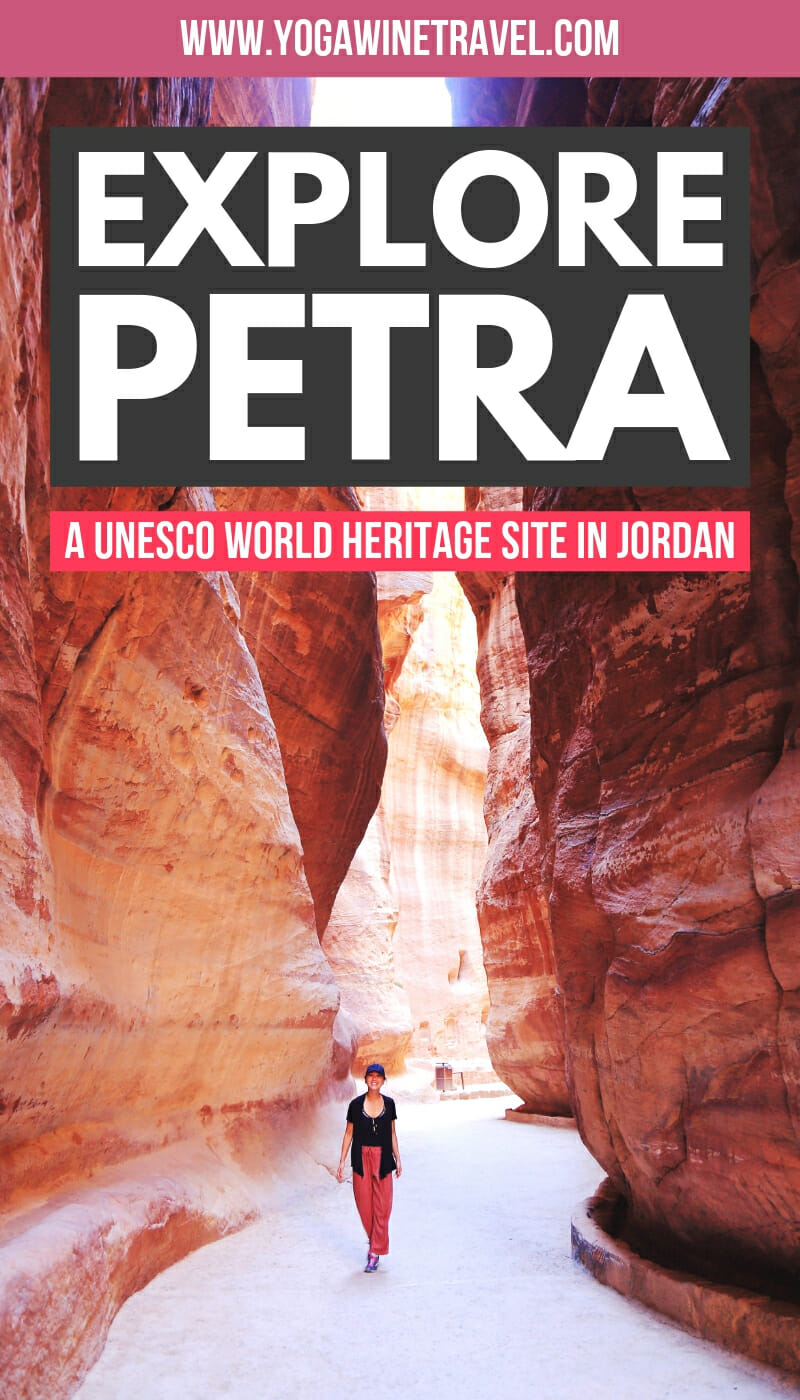
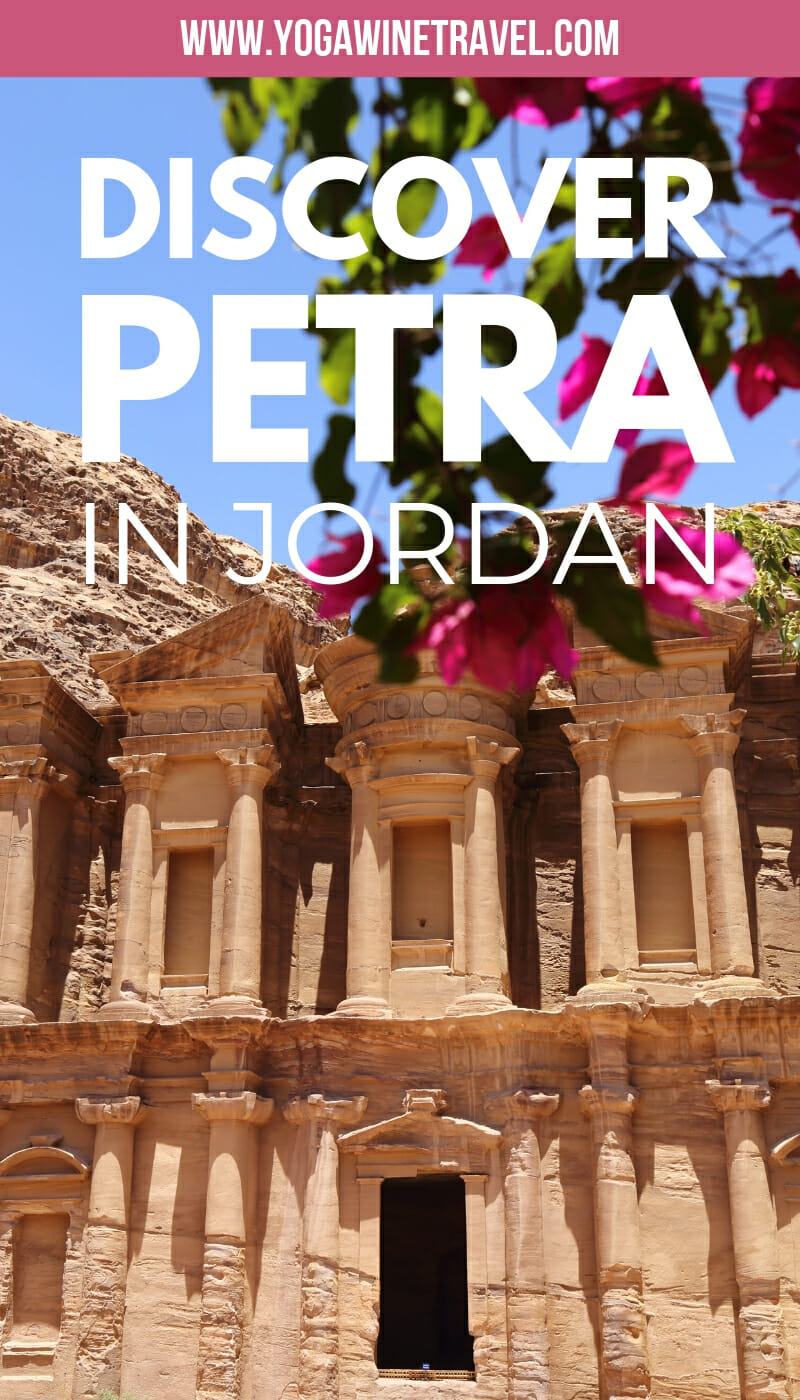
This article contains affiliate links. If you choose to book using these links, I will earn a small commission at no extra cost to you. Thank you for supporting my website by using these links.
Enjoyed reading this article? Subscribe to the mailing list!
* Unsubscribe at any time. Your e-mail address will only ever be used to send the occasional Yoga, Wine & Travel newsletter.

